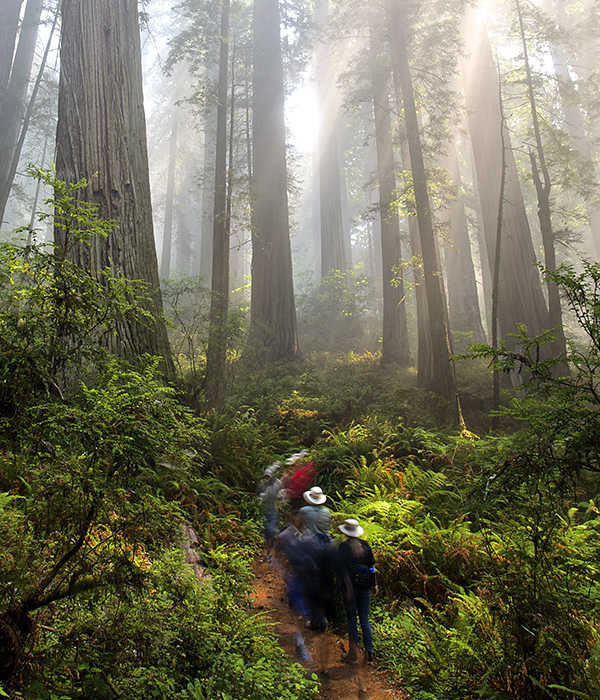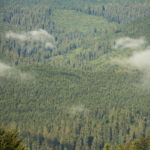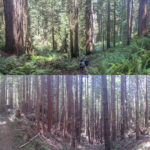Contacts:
Robin Carr, Landis Communications
Phone: (415) 766-0927 | Email: redwoods@landispr.com
First-Ever State of the Redwoods Conservation Report Provides Scientific Assessment of Condition, Trends and Challenges for Entire Redwood Ecosystems
Accompanying Vision Statement Outlines a Path for Improving Conditions Over the Next 100 Years
Download the full press release
San Francisco, Calif. (April 16, 2018) – Coast redwoods and giant sequoia are two of California’s iconic symbols and greatest natural treasures, and the work to save them is only just beginning. Save the Redwoods League, the San Francisco-based nonprofit that helped launch the conservation movement in the U.S. 100 years ago, today released its first-ever State of the Redwoods Conservation Report, detailing today’s most pressing challenges for these forests and their plan for action. Among the findings in the report: coast redwood and giant sequoia ecosystems require significant, science-driven intervention and restoration given the impacts of clearcutting, human development, climate change, and altered fire regimes, which threaten forests across public and private land. Given the extraordinary value of redwood and sequoia forests in sequestering carbon, cleaning our water, providing resilient habitat, scenic beauty and inspiration, the degraded state of these forests must be addressed.
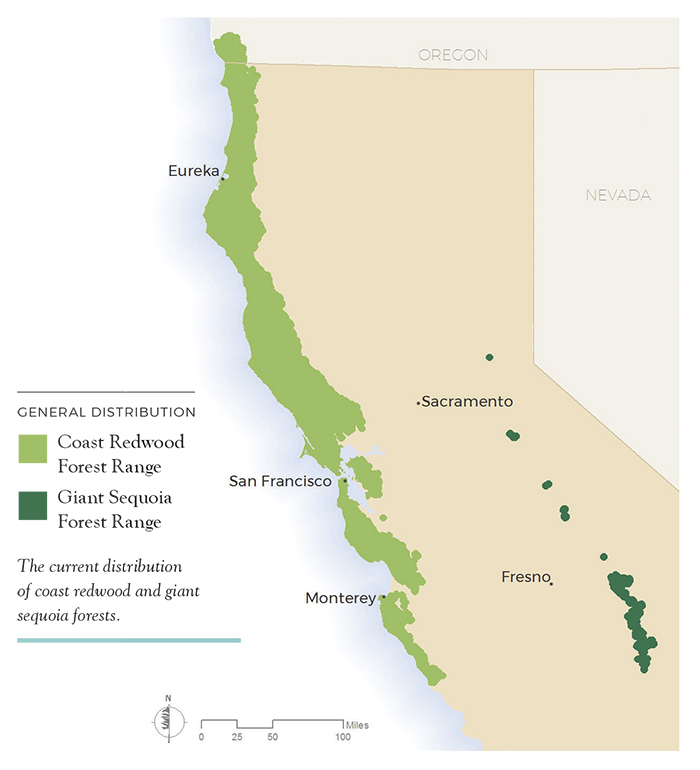
“This report is our wake-up call; a reminder of how critical a healthy, resilient redwood forest is to the future of California and beyond,” said Sam Hodder, president and CEO of Save the Redwoods League. “Our centennial comes at an extraordinary moment. In response to the substantial, cumulative challenges facing our redwood forests documented in this report, we have both the opportunity and the responsibility to heal and regenerate the old-growth forests of future generations.”
The comprehensive report, the culmination of years of research from Save the Redwoods League scientists and our partners, provides a contemporary analysis of the health and condition of the entire coast redwood and giant sequoia forest systems (key findings below). The coast redwood forest stretches from Big Sur north to the California-Oregon border, and giant sequoia groves grow exclusively along the western slope of the Sierra Nevada. The report assesses the health of coast redwood and giant sequoia forest ecosystems against four key conservation metrics old-growth forest structure, protected forestland, anthropogenic (human-caused) forest edge impacts, and fire readiness.
Key Findings
Coast Redwood
- Old-Growth Forest Structure – Condition: Significant Concern
- The current extent of old-growth forest in the coast redwood ecosystem is only five percent of the original 2.2 million-acre forest and is, therefore, of significant concern. Surrounding the remaining 113,000 acres of old-growth today is 1.4 million acres of logged redwood forest, half of which is young and with an average trunk diameter of just 8 inches.
- Protected Forestland – Condition: Caution
- Only 22 percent of the coast redwood ecosystem is highly protected from commercial logging, subdivision and development.
- Anthropogenic Forest Edge Impacts – Condition: Caution
- Since the California Gold Rush in the 19th century, an estimated 27 percent (600,000 acres) of the original coast redwood forest ecosystem was lost when the forest was converted for human use. Nearly 40 percent of the remaining coast redwood forest fragmented by roads, residential development and agriculture, resulting in degraded habitat quality along the forest edge.
- Fire Readiness – Condition: Significant Concern
- Today, 88 percent of the coast redwood ecosystem is burning moderately to significantly less frequently than prior to European settlement. With wildfire frequency predicted to increase with climate change and significant fuels accumulation in the forest today, the ecosystem is vulnerable to severe fire damage.
Giant Sequoia
- Old-Growth Forest Structure – Condition: Caution
- Historic logging of giant sequoia groves altered the forest structure and removed mature giant sequoia in at least 24 groves. Out of the 48,000 total acres of giant sequoia forest today, more than 11,000 acres were once heavily logged, and approximately 5,000 more acres were partially logged.
- Protected Forestland – Condition: Good
- The vast majority of giant sequoia groves are held in public or tribal ownership, with only 1,200 acres privately owned today.
- Anthropogenic Forest Edge Impacts – Condition: Good
- The giant sequoia forest experiences anthropogenic forest edge impacts on 16 percent of its ecosystem overall. Roads are the primary type of human infrastructure affecting the giant sequoia forest, followed by residential development.
- Fire Readiness – Condition: Significant Concern
- Fires once burned frequently across the Sierra Nevada and through giant sequoia groves, but today, 93 percent of the ecosystem is burning moderately to significantly less frequently than prior to European settlement. With fire frequency and intensity predicted to increase due to climate change, and with the tree mortality epidemic creating crisis-level fuels accumulation in the forests, the ecosystem is vulnerable to severe fire damage.
“By studying the entire coast redwood and giant sequoia forest ranges, across public and private lands, we are able to see what stressors are most critical to address,” said Emily Burns, director of science for the League. “With this new insight in hand, we can catalyze new conservation action to protect these remarkable wonders of the natural world.”
The Upshot: Redwoods and Climate Change
The State of the Redwoods Conservation Report describes how redwood forests play a key role during this period of accelerated climate change. Coast redwood and giant sequoia forests store extraordinary amounts of carbon — significantly more than any other forest type on the planet. Additionally, these forests have an important role to play in helping attenuate the impact of human-accelerated climate change on multiple species and habitats: “Higher-than-expected growth in recent decades suggests that redwoods will persist and enable the redwood forest to be a critical climate refuge for species acutely threatened by climate change,” according to the report.
Looking Ahead – A New Vision
In a world increasingly defined by the deterioration of global natural treasures — receding glaciers, dammed and dying rivers, unprecedented rates of species extinction — Save the Redwoods League has a story of hope and resilience to tell. The first chapter, over the course of the past one hundred years, tells how they saved treasured examples of the wild and ancient groves that once dominated California’s coast and mountains.
Now, at the 100-year mark, they begin a second chapter, wherein we strive together to heal the young redwood forests that surround and sustain the protected ancient groves. The League has a vision to set in motion the regeneration of the redwood forest that will inspire future generations and restore resilience back into California’s most iconic ecosystem. And they will endeavor to renew our human connection to the natural world through the treasured gateways of California’s dedicated redwood parks.
Save the Redwoods League envisions vibrant redwood forests of the scale and grandeur that once graced the California coast and the Sierra Nevada, protected forever, restored to grow old again, and connected to people through a network of magnificent parks and protected areas that inspire all of us with the beauty and power of nature.
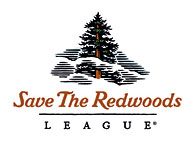
Save the Redwoods League, one of the nation’s oldest conservation organizations, is celebrating 100 years of protecting and restoring redwood forests, and connecting generations of visitors with the beauty and serenity of the redwood forest. Its 19,000 supporters have enabled the League to protect more than 200,000 acres of irreplaceable forest and help create 66 redwood parks and reserves. For more information, visit SaveTheRedwoods.org.
Tags: 2018, centennial, Centennial Celebration, Centennial Vision, Press Release, State of the Redwoods Conservation Report
